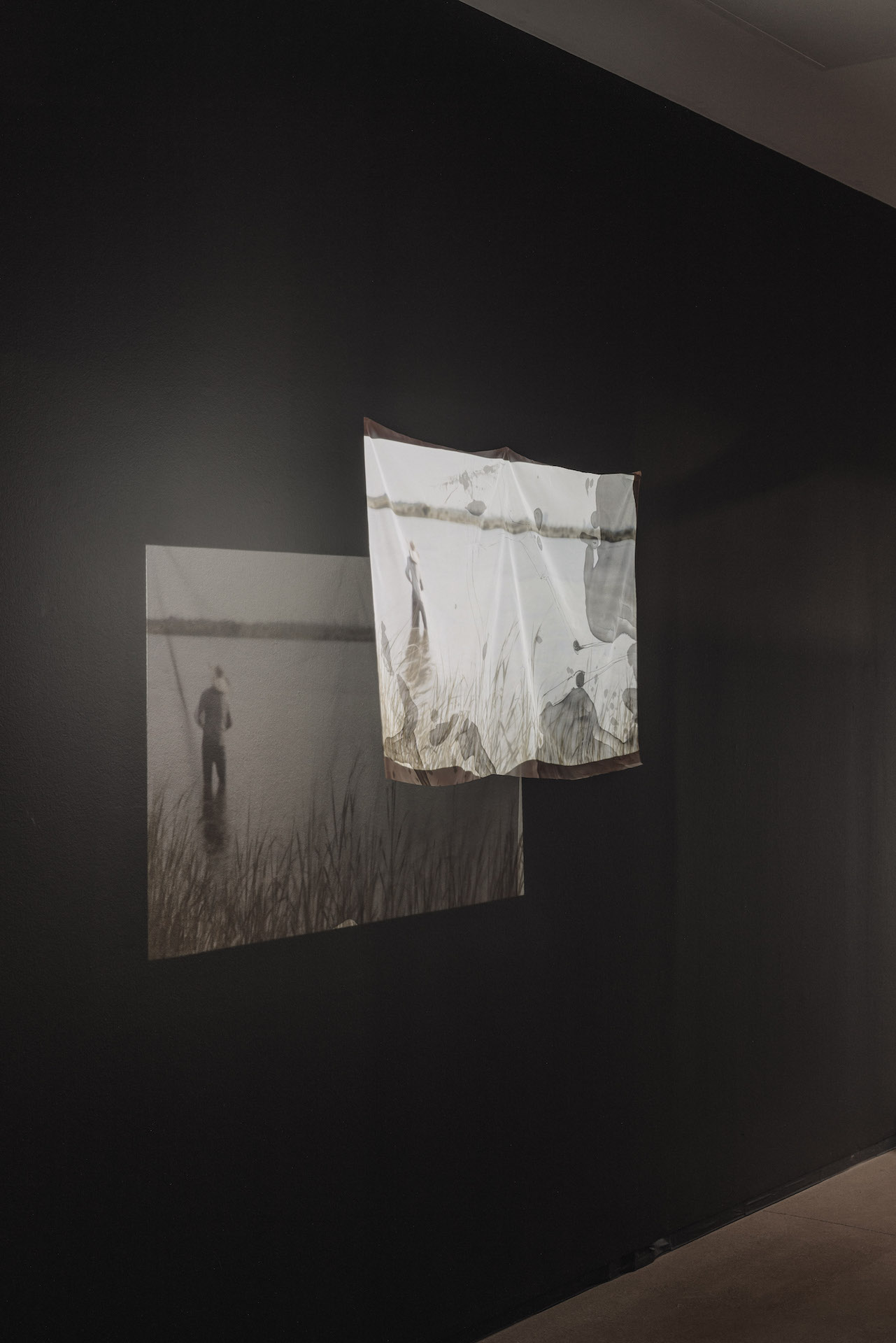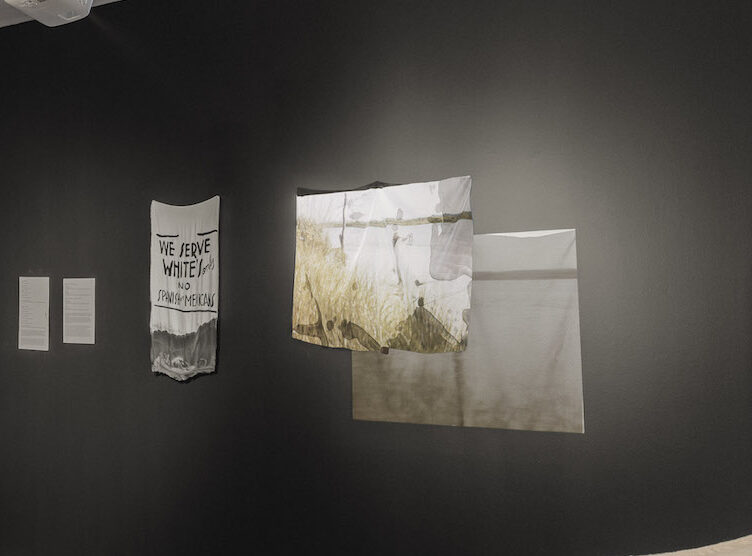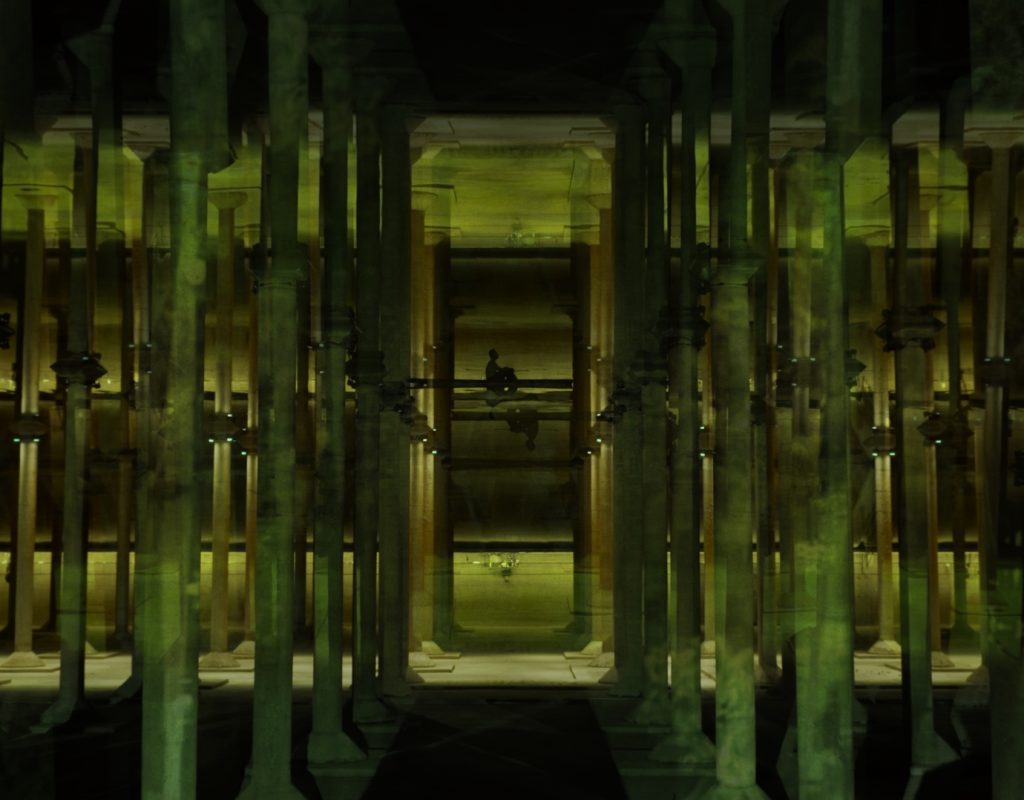
Lifeblood
Data Sheet
Credits
DETALLES DEL PROYECTO
Lifeblood is the name of the solo exhibition, in Blaffer Art Museum of Houston University, curated by Steven Matijcio, in which Tania Candiani explored the relationship between the birth of the City of Houston and the waterways that cross its geography. The exhibition is a journey that crosses the past and the present, the living and the lost, to channel the many voices that resonate in the soul of Houston.
The soul of the exhibition is the video Echoing Landscape.
An immersive sound and video installation with poetic narration that tells the fragmented history of waterways in Houston through four chapters: a pre-colonial past, violence and labor, urban development, and the dormant cistern. Layering ecological and technological infrastructures from the past and present, the film’s four chapters invoke the specters of history to reveal what might lay in our future.
The first chapter, denoted by green as a reference to nature, evokes the original stewards of the land and water – Karankawa, Atakapa and Akokisa people – symbolized by the solitary figure on a canoe navigating a reflective plane of water. The second chapter, represented by gold, summons the history of cotton production and the extraction of land and labor through a re-staging of work songs commonly heard amongst enslaved Black field workers. The songs perform historical archives as an echo heard through time. In the third chapter, ushered by red light, projects footage of undeveloped bayou waters is projected onto the columns of the Buffalo Bayou Cistern to invoke a history of modified territory and the dredging of the bayous, which allowed for easier navigation for commercial vessels and urban development. The fourth chapter, depicted by the color silver – a reference to minerals and concrete – closes the film by focusing on the Cistern as a womb and tomb. The obsolete engineering work becomes the subject to examine distortions of time and history. Each chapter enlivens the enshrined narratives of its respective era to recognize the relationship with water as an indissoluble part of defining people, land, and power.
Commissioned by the Blaffer Art Museum with support from the Cynthia Woods Mitchell Center for the Arts.
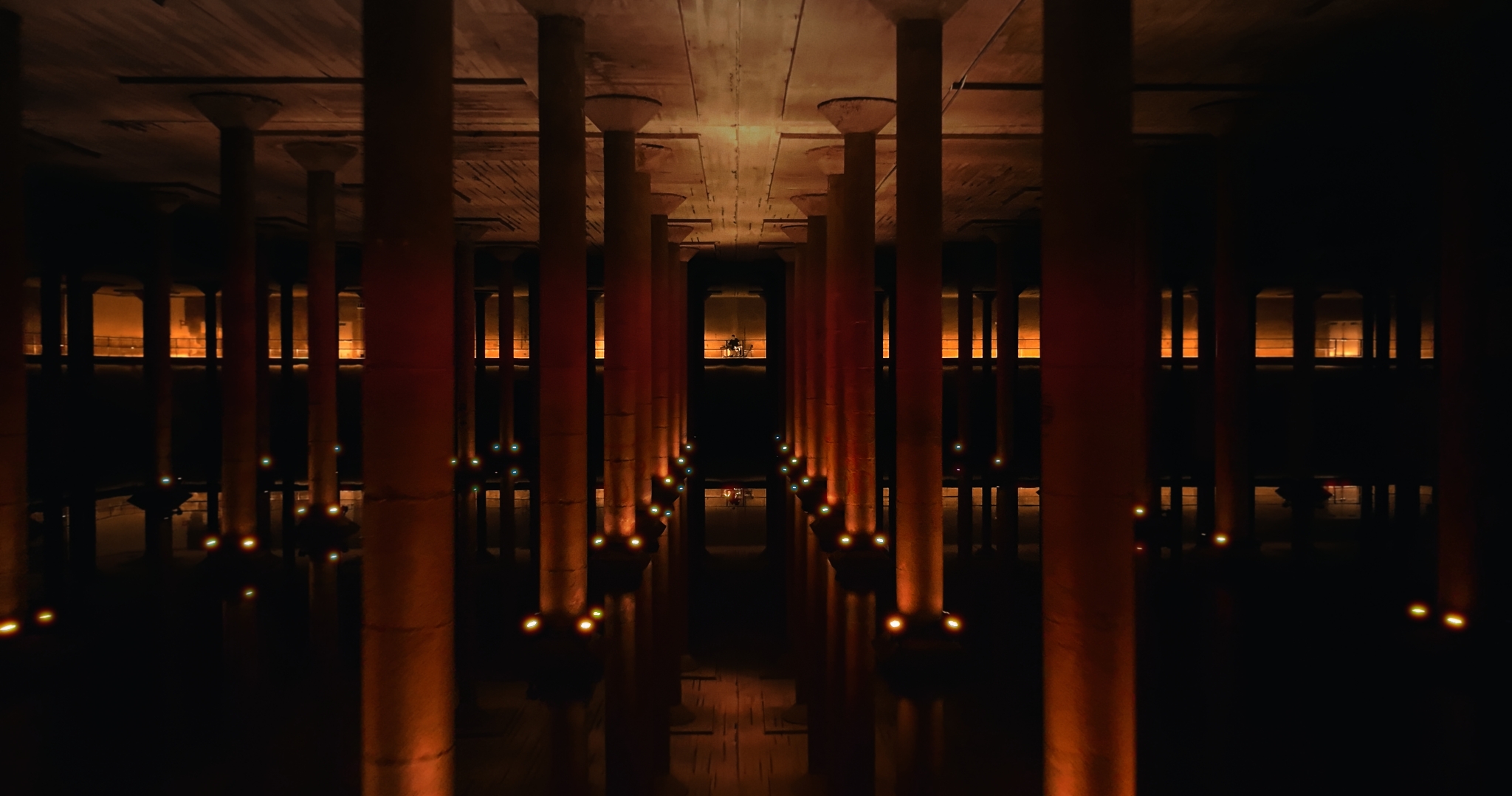
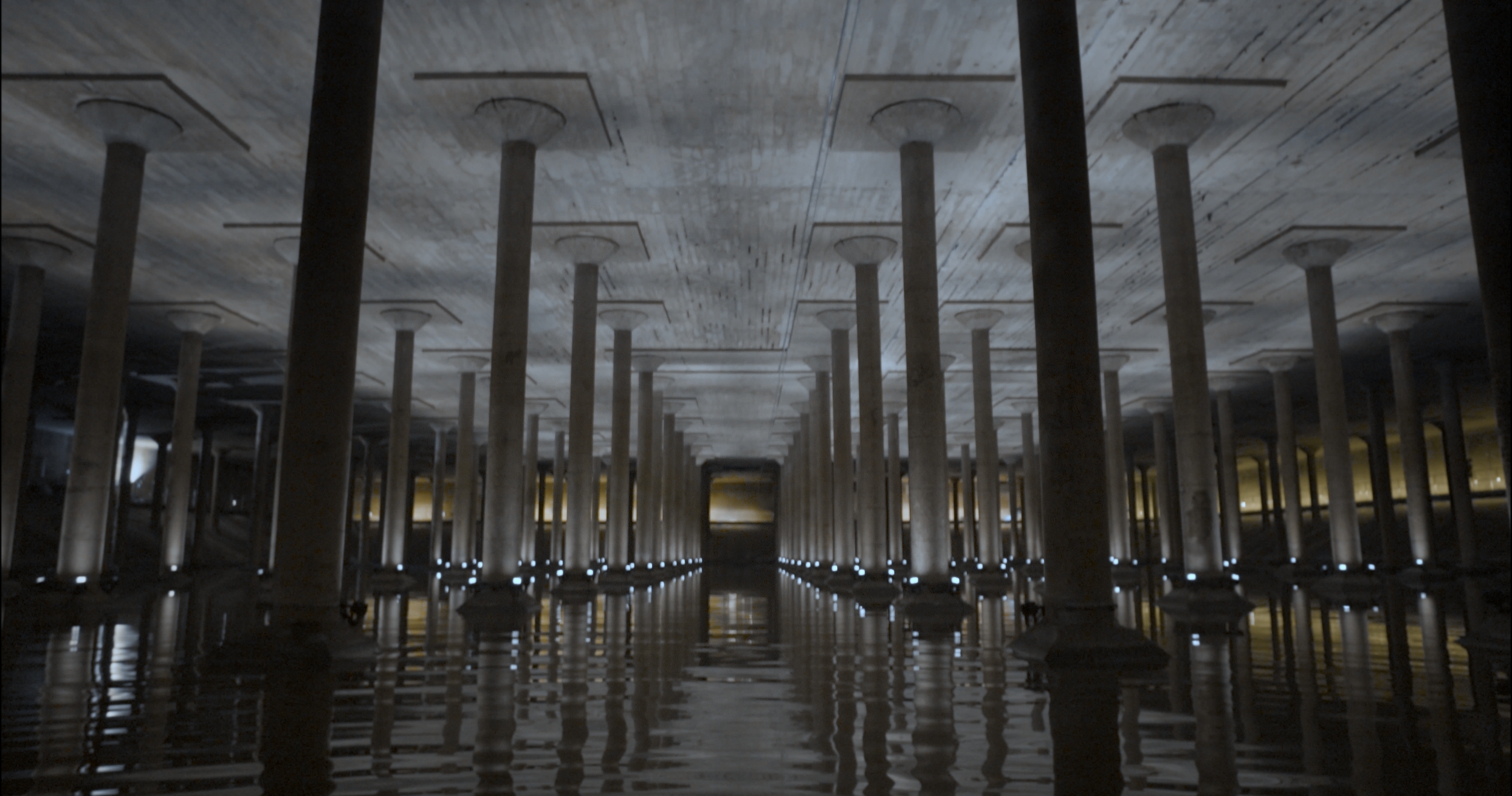
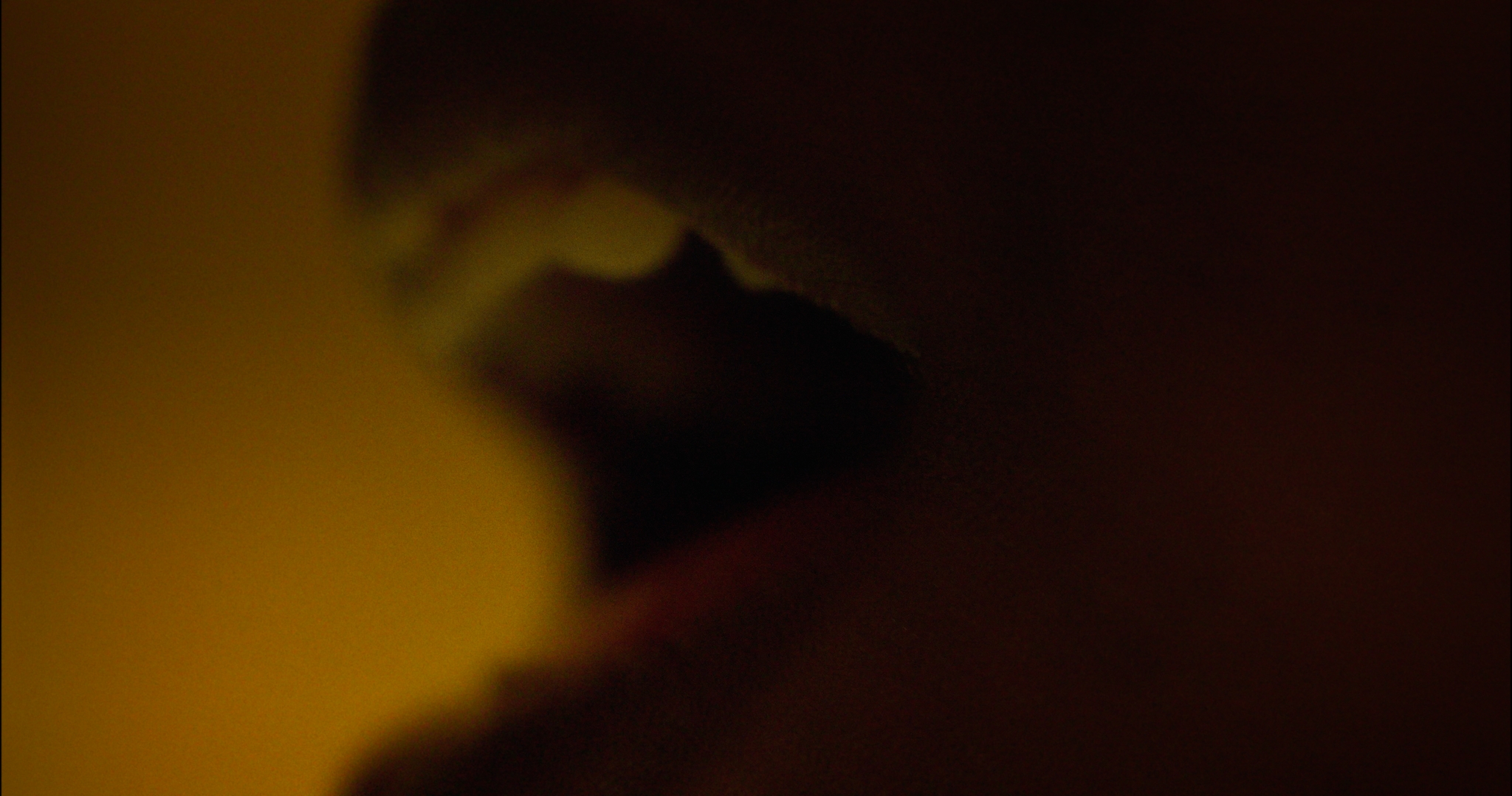
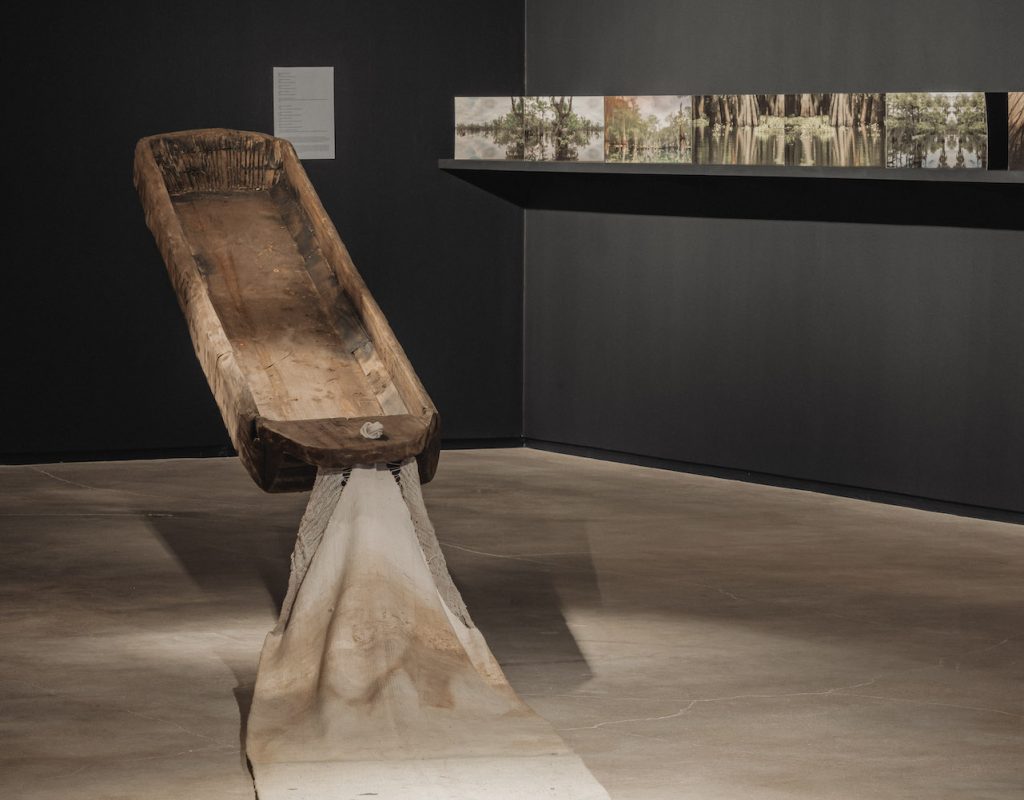
Buffalo Bayou, 1953 & Caddo Canoe
Data sheet
Credits
DETALLES DEL PROYECTO
Prior to the 1940s, Buffalo Bayou meandered circuitously through the bends and far reaches of tributaries across Waller, Fort Bend, and Harris Counties. Efforts to straighten the bayou for better navigation and urban development have resulted in severe losses to wildlife reliant upon the natural flows of the water. The embroidered brown line weaving through the cotton sacks documents the original path of the bayou prior to the structural controls to the land, as the overlapping red thread maps the industrial efforts to straighten the water’s course in 1953.
The hand carved Caddo Canoe, as seen in the neighboring film Echoing Landscapes, is a recreated canoe found in the Louisiana bayou and traced to the traditions of the Caddo people who are indigenous to the western region of Oklahoma. The phantasmal canoe enters into space and fuses with woven tapestries to locate past remnants of the city’s ever-changing landscapes.
Commissioned by the Blaffer Art Museum with support from the Cynthia Woods Mitchell Center for the Arts
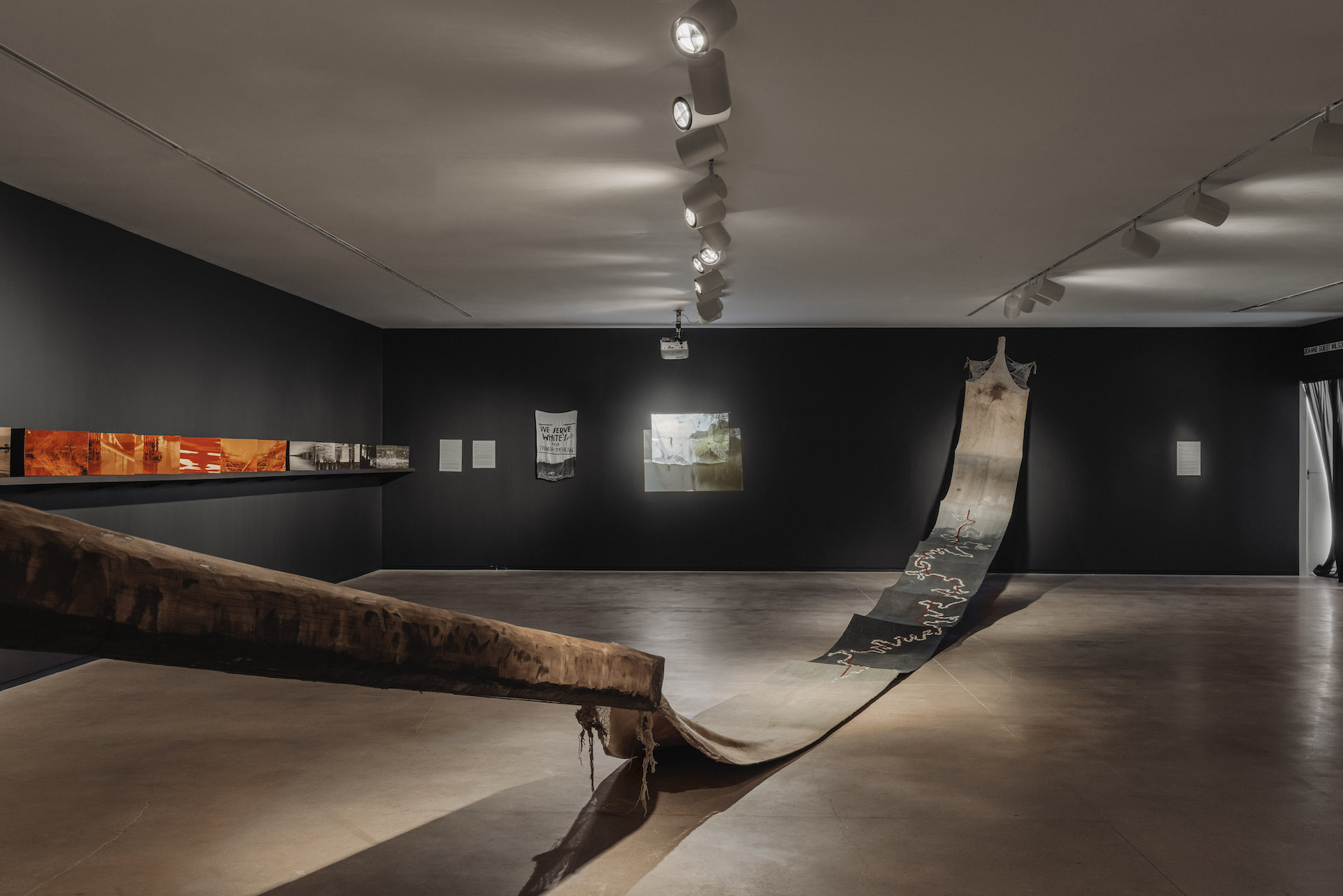
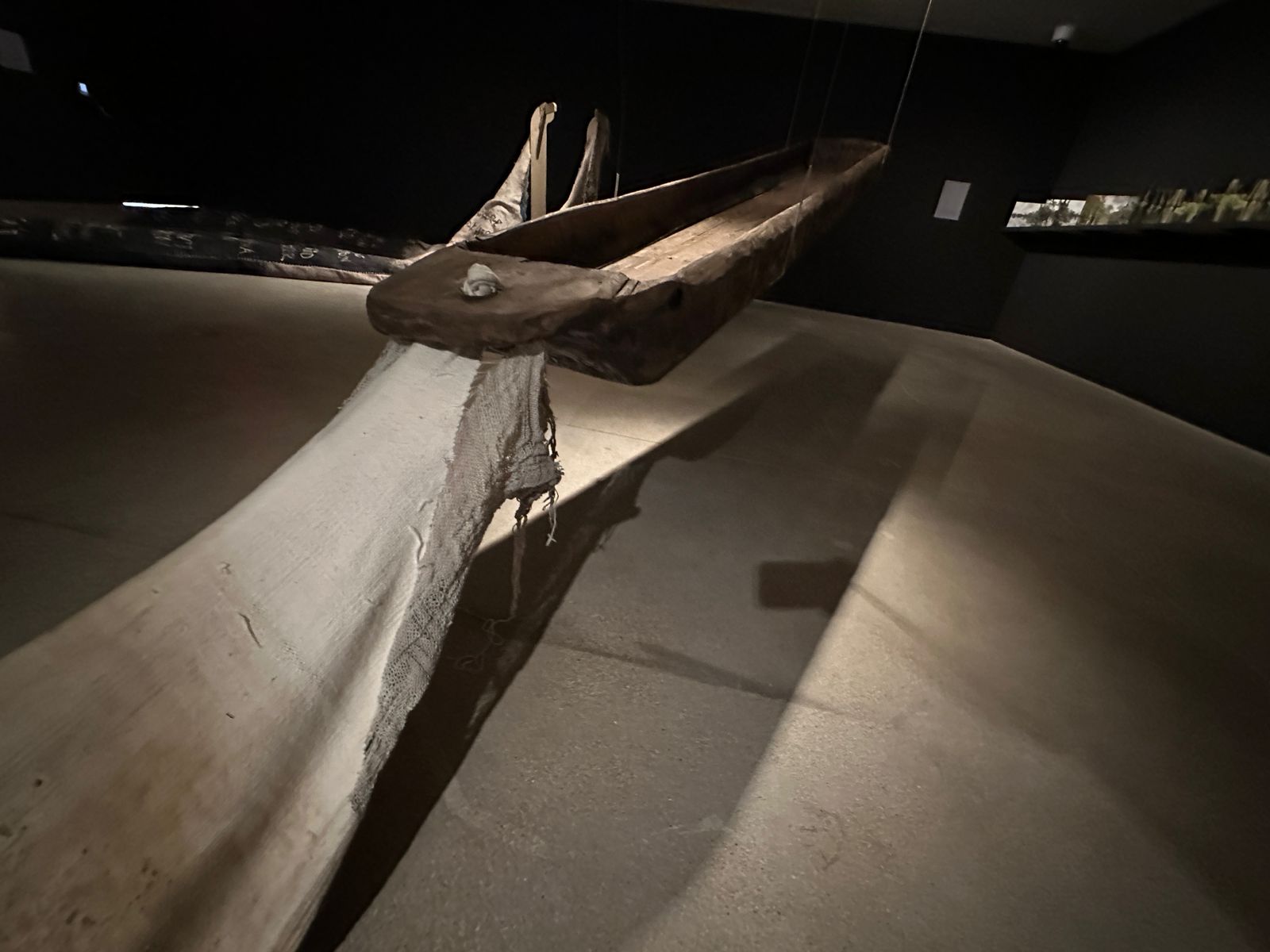
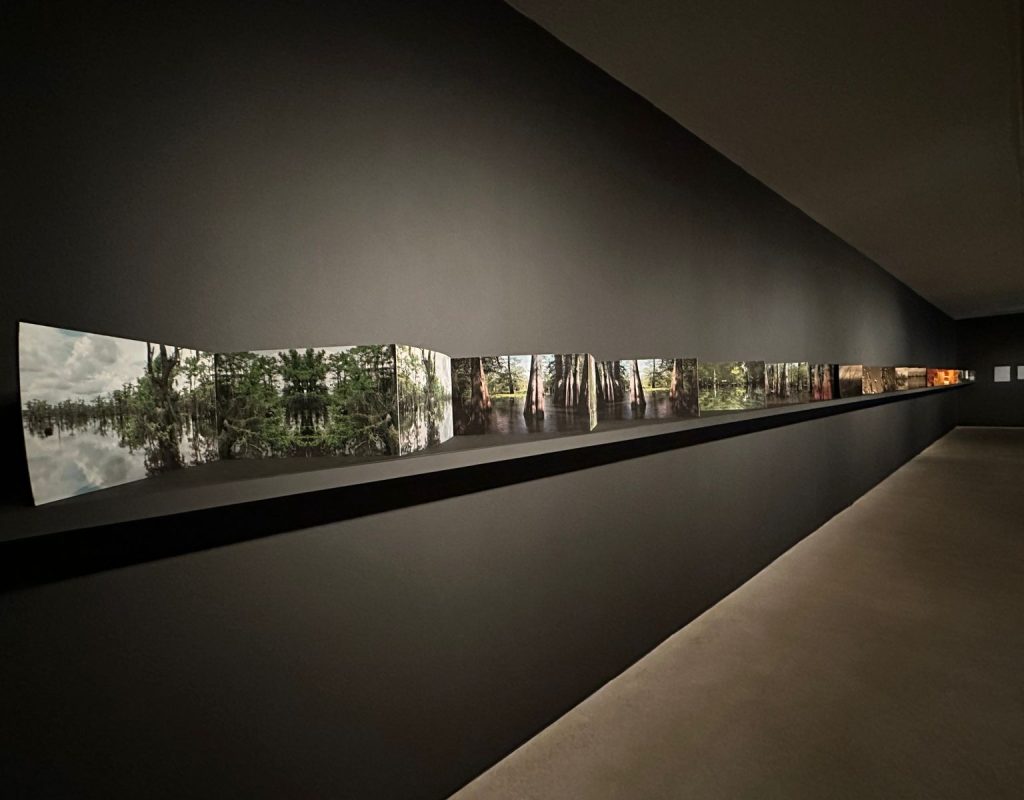
Lifeblood Book & Echo Sound Wave
Data sheet. Lifeblood Book
Data sheet. Echo Sound Wave.
DETALLES DEL PROYECTO
Four chapter photobooks that compile stills from video footage taken by Candiani and her partnering film crew of the bayou meandering from Louisiana into Texas. This video is also projected onto the columns of the Buffalo Bayou Cistern in the neighboring Echoing Landscapes video to conjure the spectral presence of the bayou’s many histories. The stories unfold in four chapters: nature prior to colonization; cotton cultivation sustained by enslaved peoples; urban development and modified territory; and the establishment of modernity through a focus on the cistern as a womb and tomb.
Just as the images of the video Echoing Landscape give shape to the Lifeblood Book, the soundscape of the film shapes the piece Eco sound wave.
This soundscape, like the film and the book, follows the same four chapters: landscape, urban development, modernity and future. Through collecting, editing and mixing the echo of different moments of the day, the four elements are fused by visualizing soundscapes in the editing process. The 4 impression of waveforms printed on acrylic gauze, superimposed create landscape and horizon through the resonance of time and history.
Commissioned by the Blaffer Art Museum with support from the Cynthia Woods Mitchell Center for the Arts
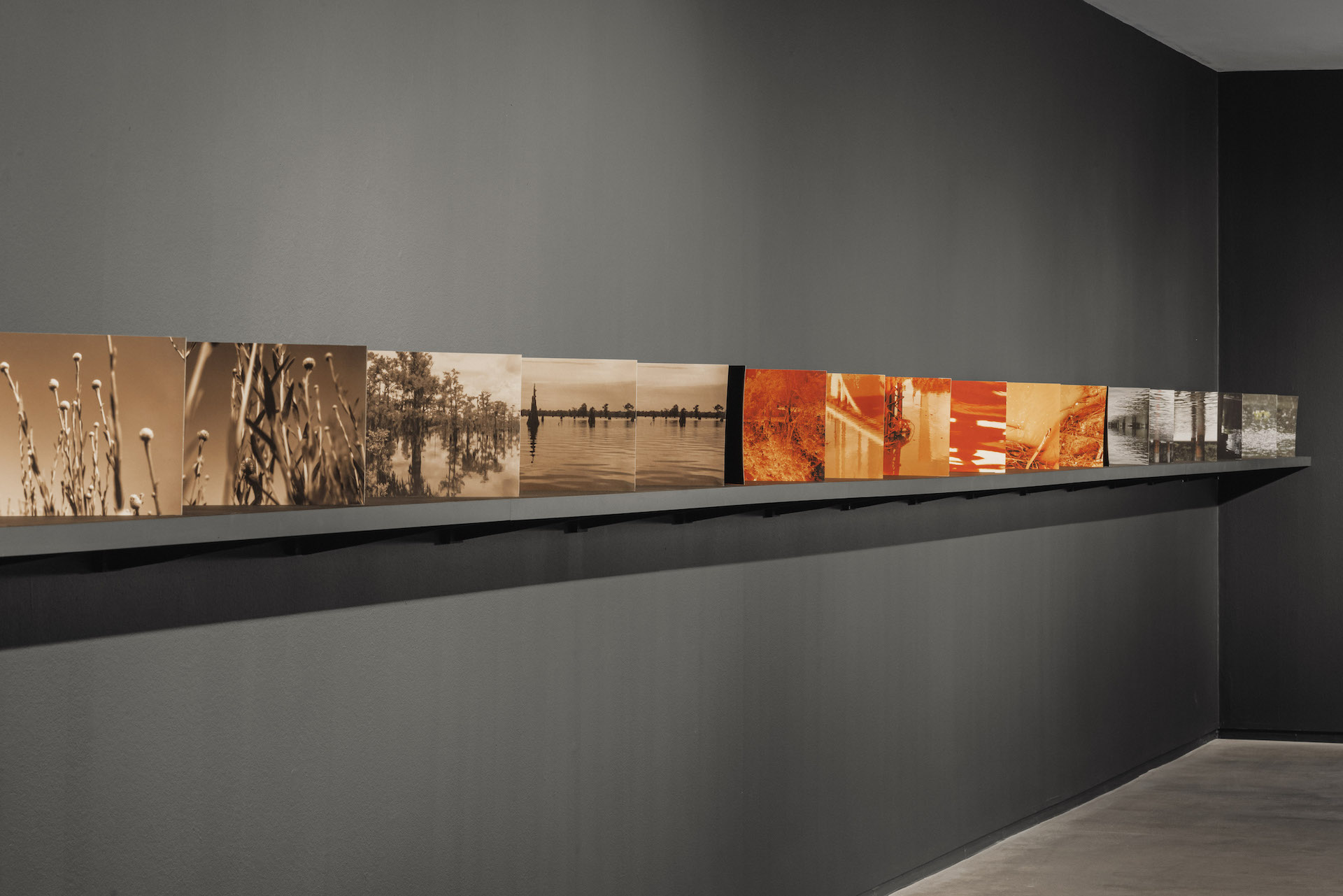
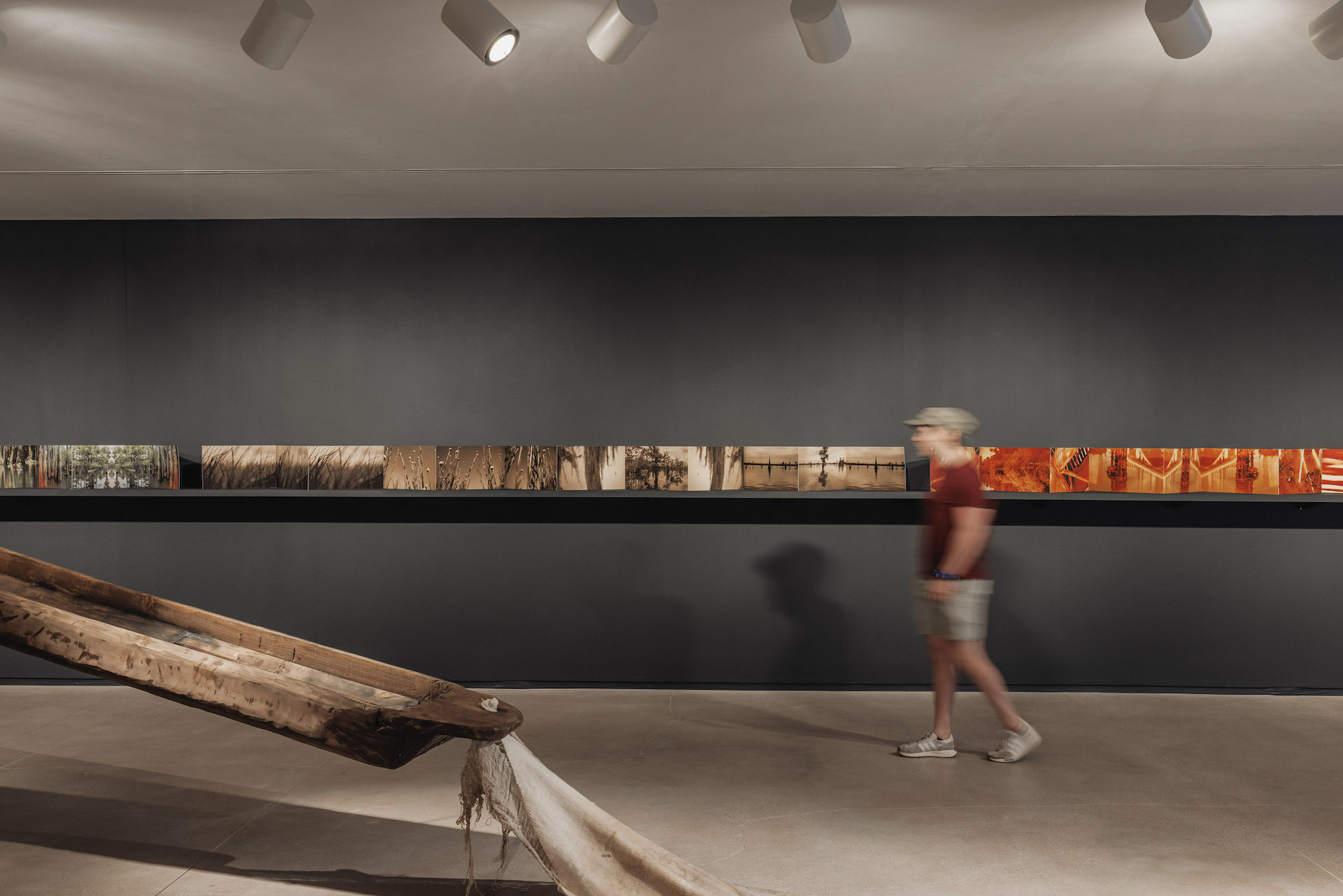
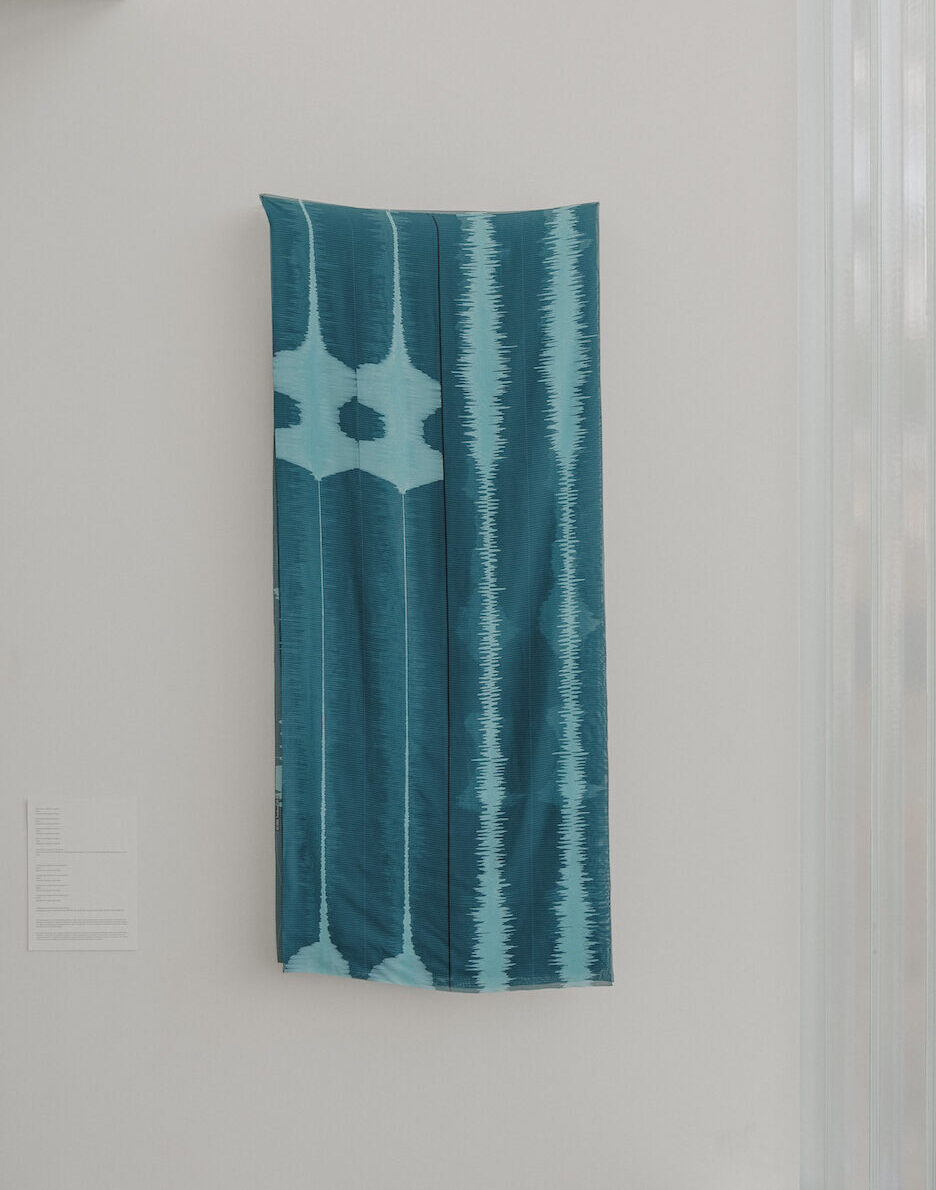
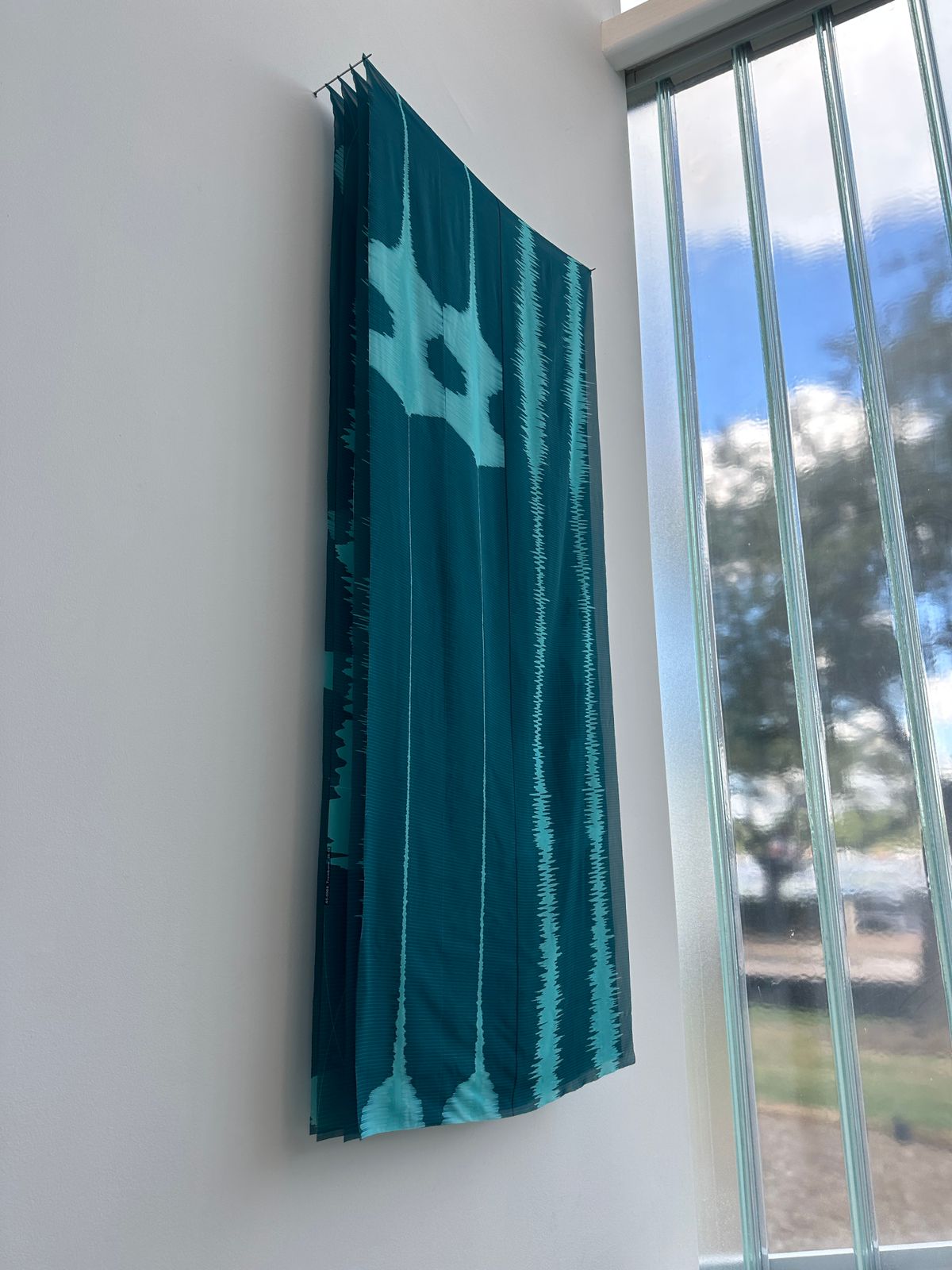
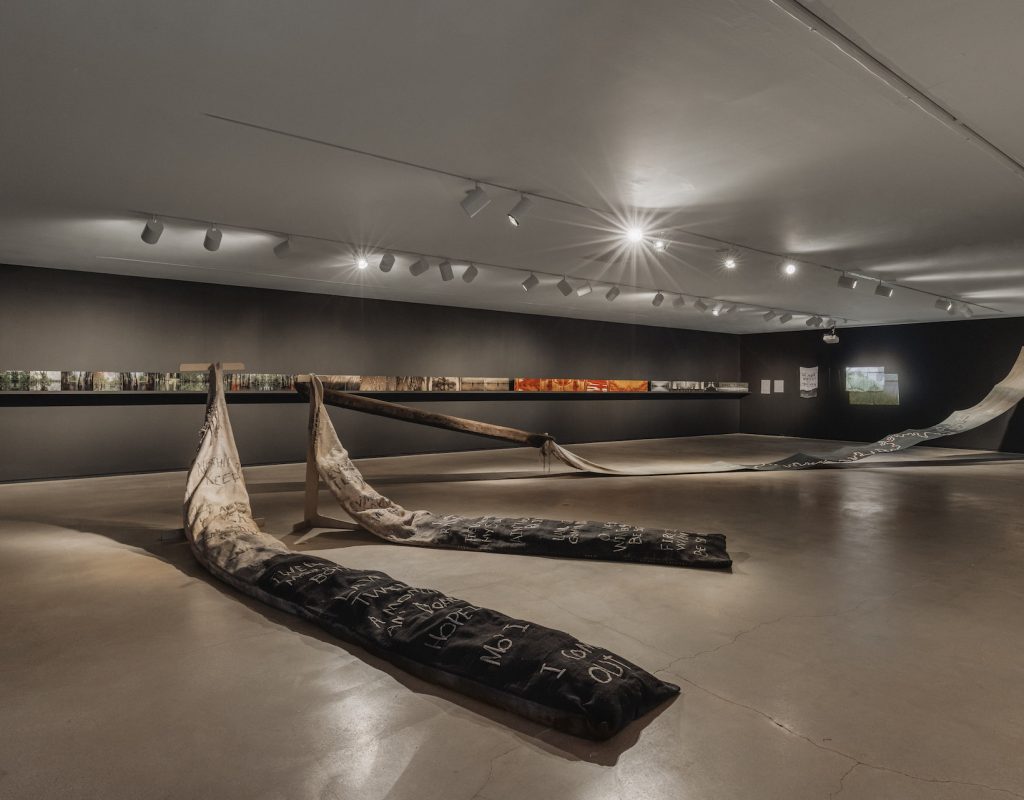
Work Songs
Data Sheet
Credits
DETALLES DEL PROYECTO
These works reference recordings from cotton fields in historical sound lyrics archives, creating resonances from the past that reverberate through the rhythms of collective grief, mourning, and remembrance. Working with Josh Kun, Professor in the Annenberg School for Communication and Journalism at the University of Southern California, the artist re-staged lyrics in the video work and has woven them into/onto extended cotton sacks. The work songs Nothin’ to Keep and I Got a Rainbow by Ed Lewis reference the invisible and enslaved labor who are so rarely acknowledged or celebrated through the processes of colonization, modernity, and development.
The two cotton sacks were woven at Taller Ocho8 in Oaxaca, Mexico by Beto Ruiz and dyed with natural pigments. The black pigments were oxidized to create a gradient from white to black.
Commissioned by the Blaffer Art Museum with support from the Cynthia Woods Mitchell Center for the Arts
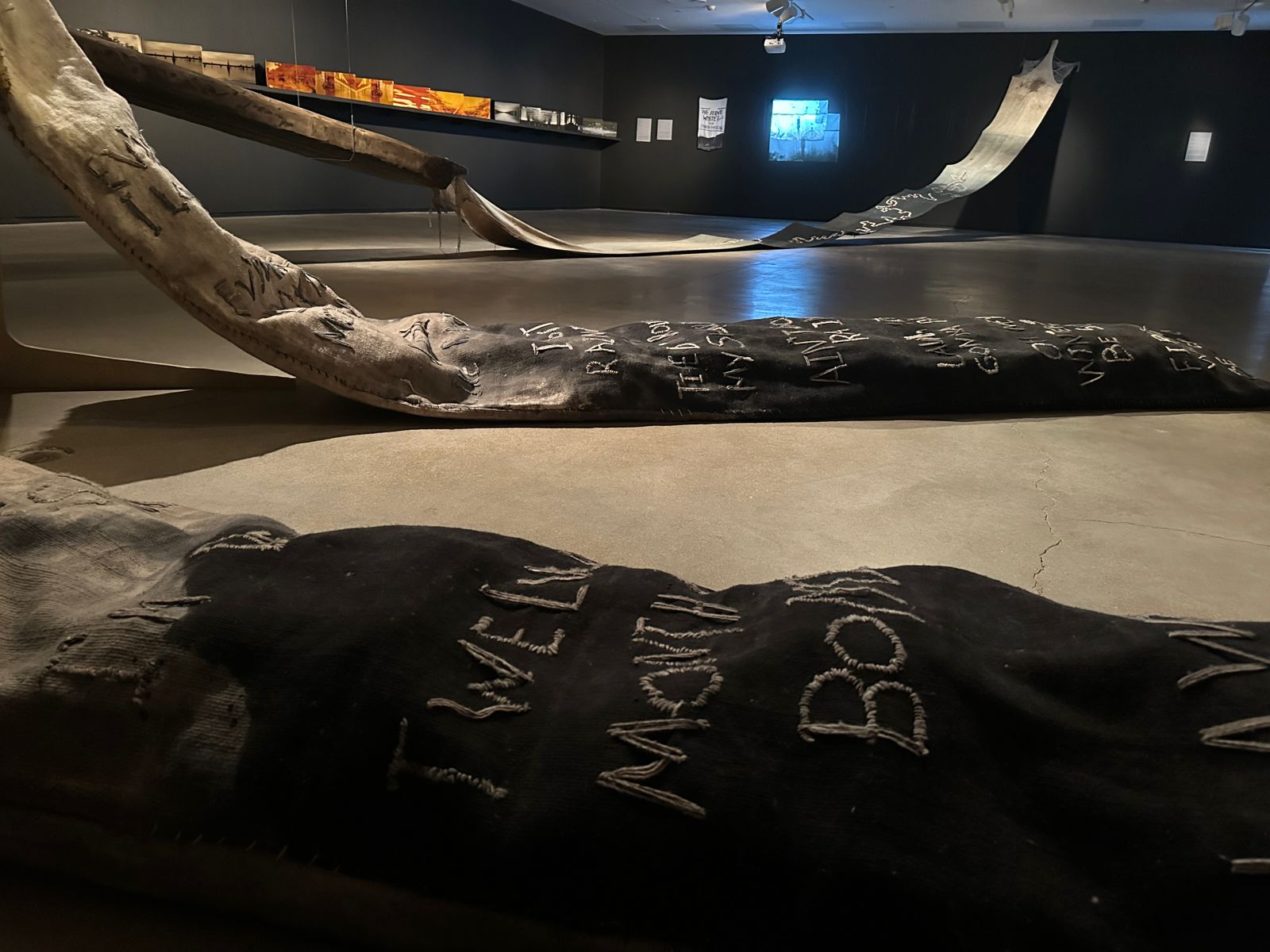
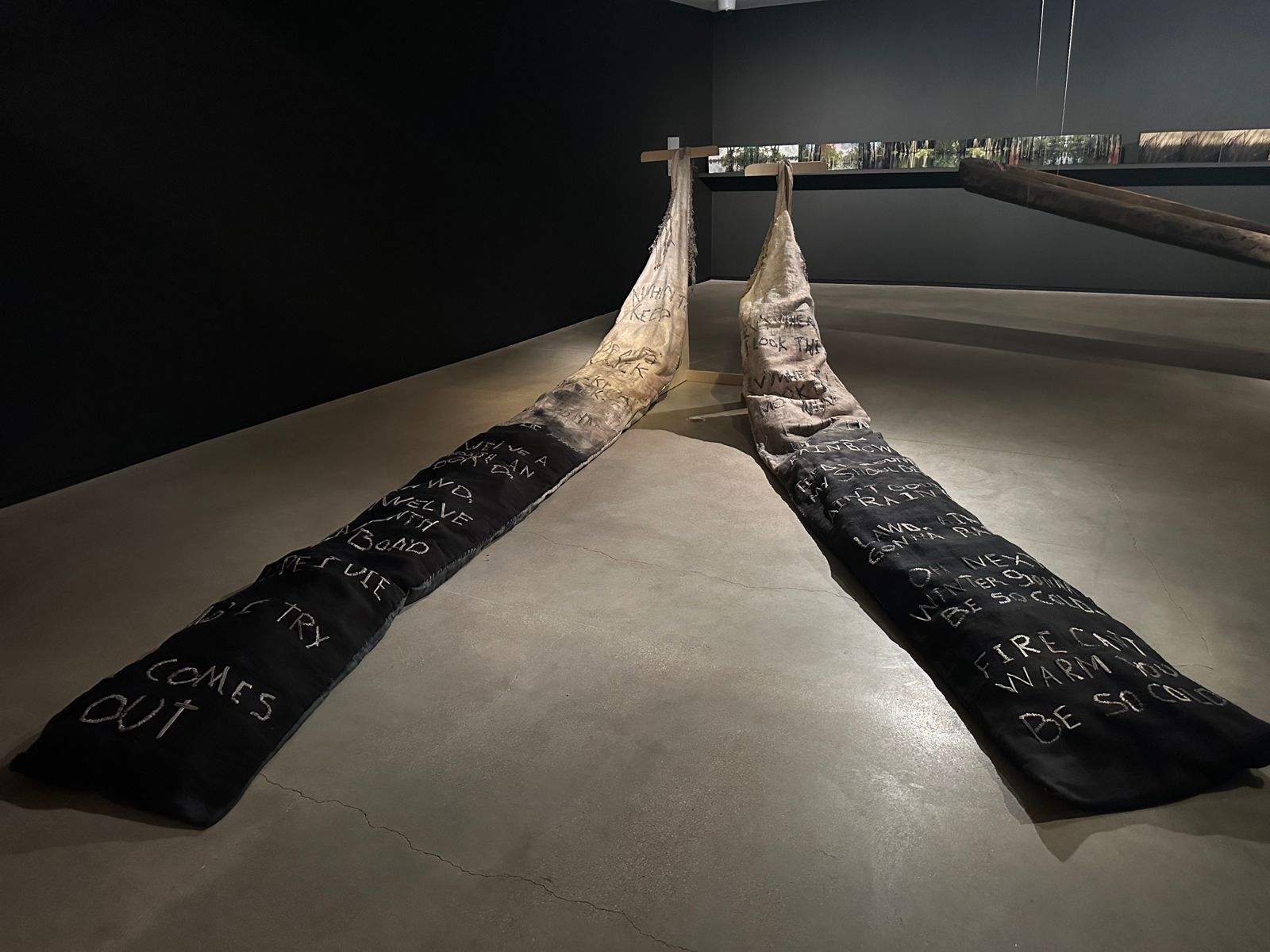
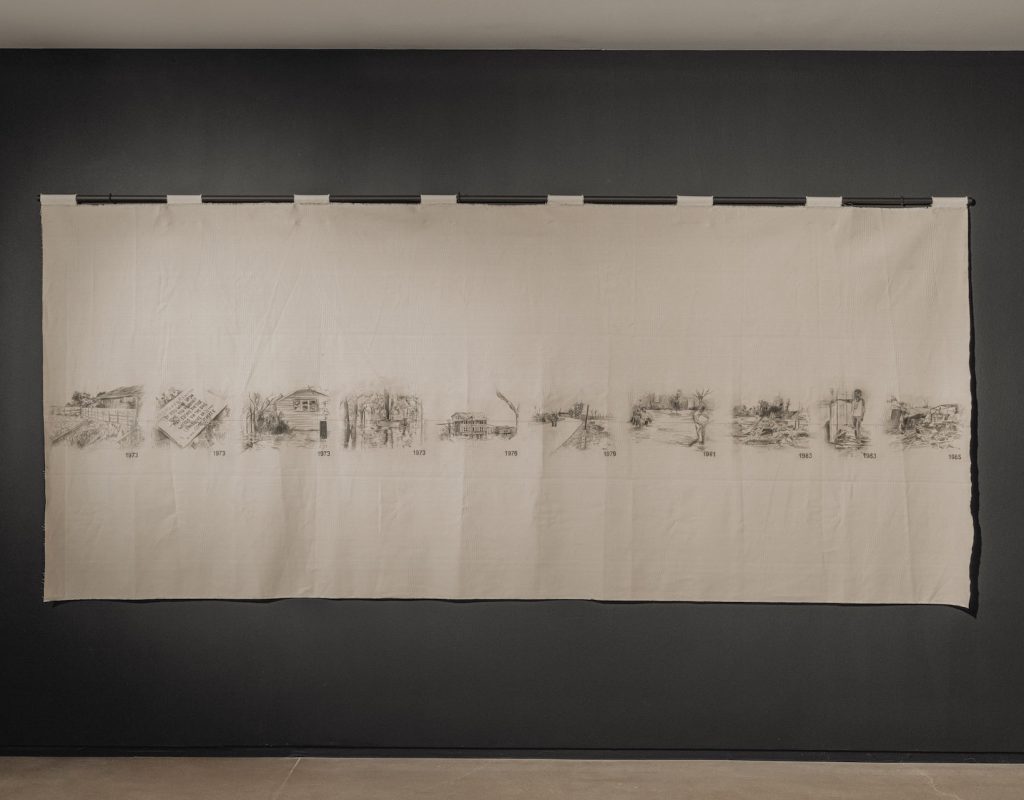
Brownwood Subdivision & Mirroring Horizons
Data sheet Brownwood Subdivision
Data Sheet Mirroring Horizons.
DETALLES DEL PROYECTO
In the 1970s, the subdivision of Brownwood near Baytown and Pasadena began to sink. This area near the Ship Channel descended around 9 feet, and eventually disappeared underwater. When Hurricane Alicia made landfall in 1983, it ravaged the entire region. Storm tides over 10 feet swept over the peninsula, and the subdivision was virtually demolished. As a result, many houses sank into the bay.
In the 1960s, hydrologist Robert Gabrysch explained that the area’s soggy, mucky land lacked the firmness of bedrock or even sand after it had been pumped for groundwater years earlier. The Baytown Nature Center was established after the area was declared uninhabitable. This 450-acre peninsula, and the manufactured homes that once inhabited it, have given way to marshes and plant life.
Candiani recreates in realistic drawings 10 moments in the history of this disappearance.
In Mirroring Horizons, an acrylic gauze print of one of the swamp scenes hanging from the ceiling accompanies bricks, ceramic tiles and concrete, rubble and remains from the Brownwood subdivision.
Commissioned by the Blaffer Art Museum with support from the Cynthia Woods Mitchell Center for the Arts
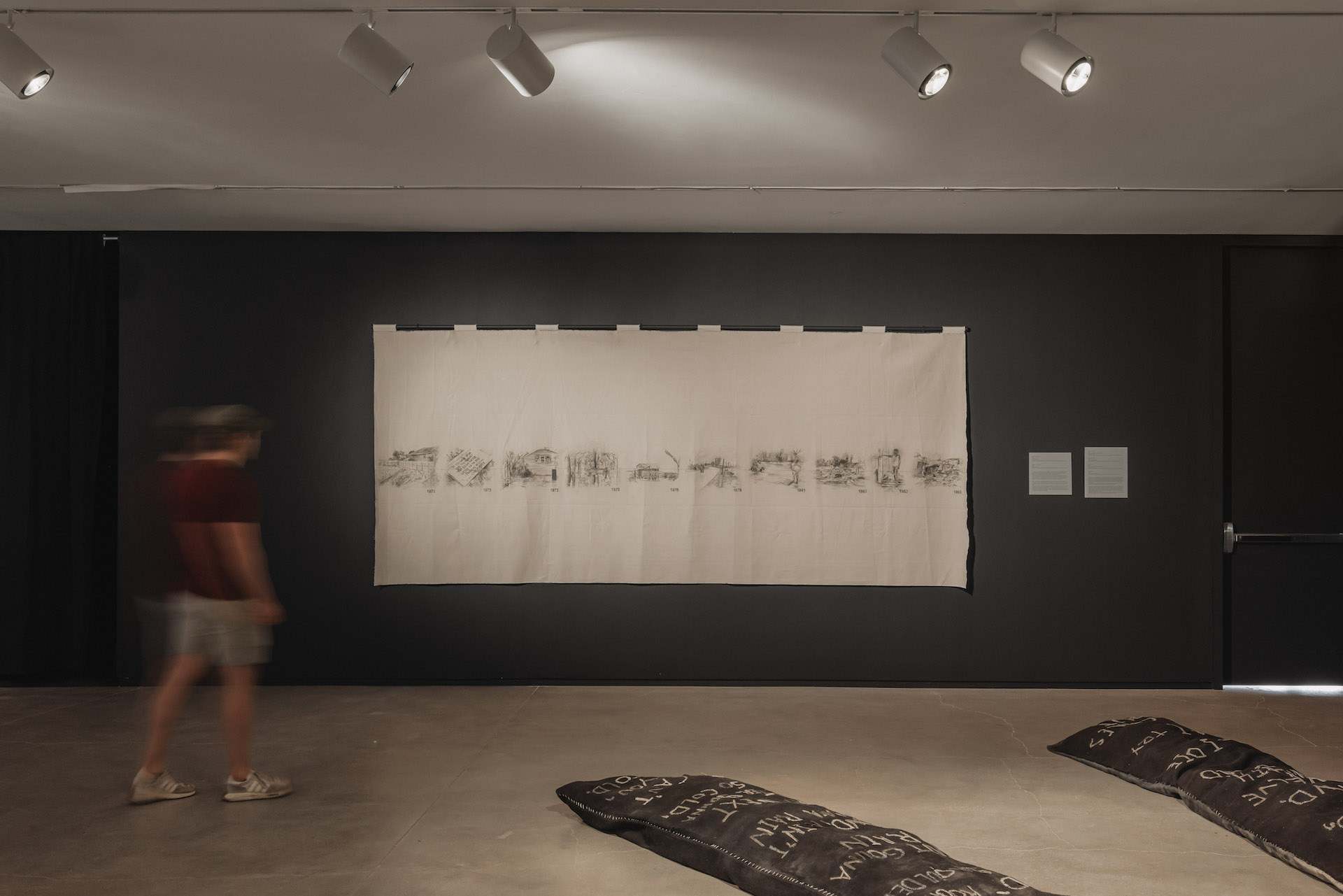
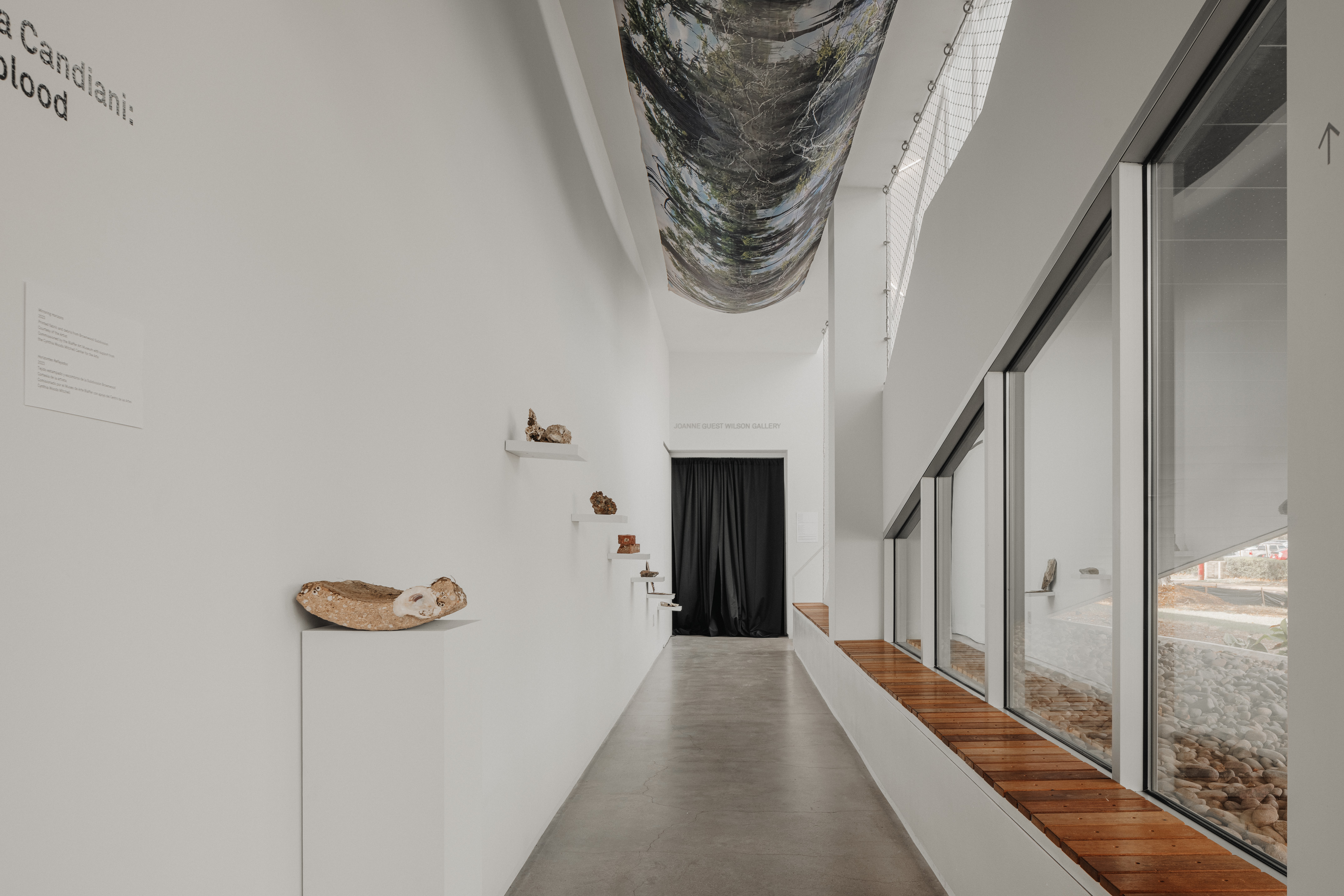
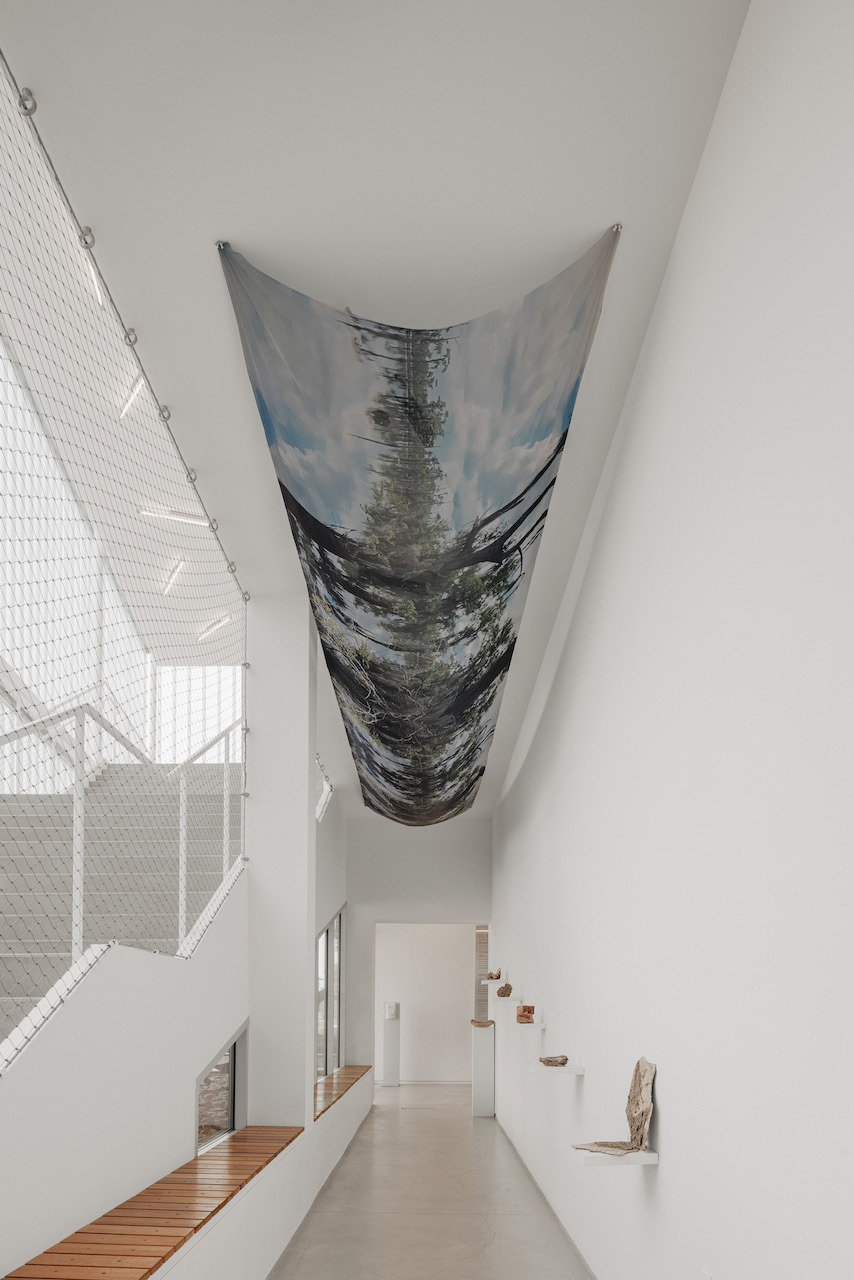
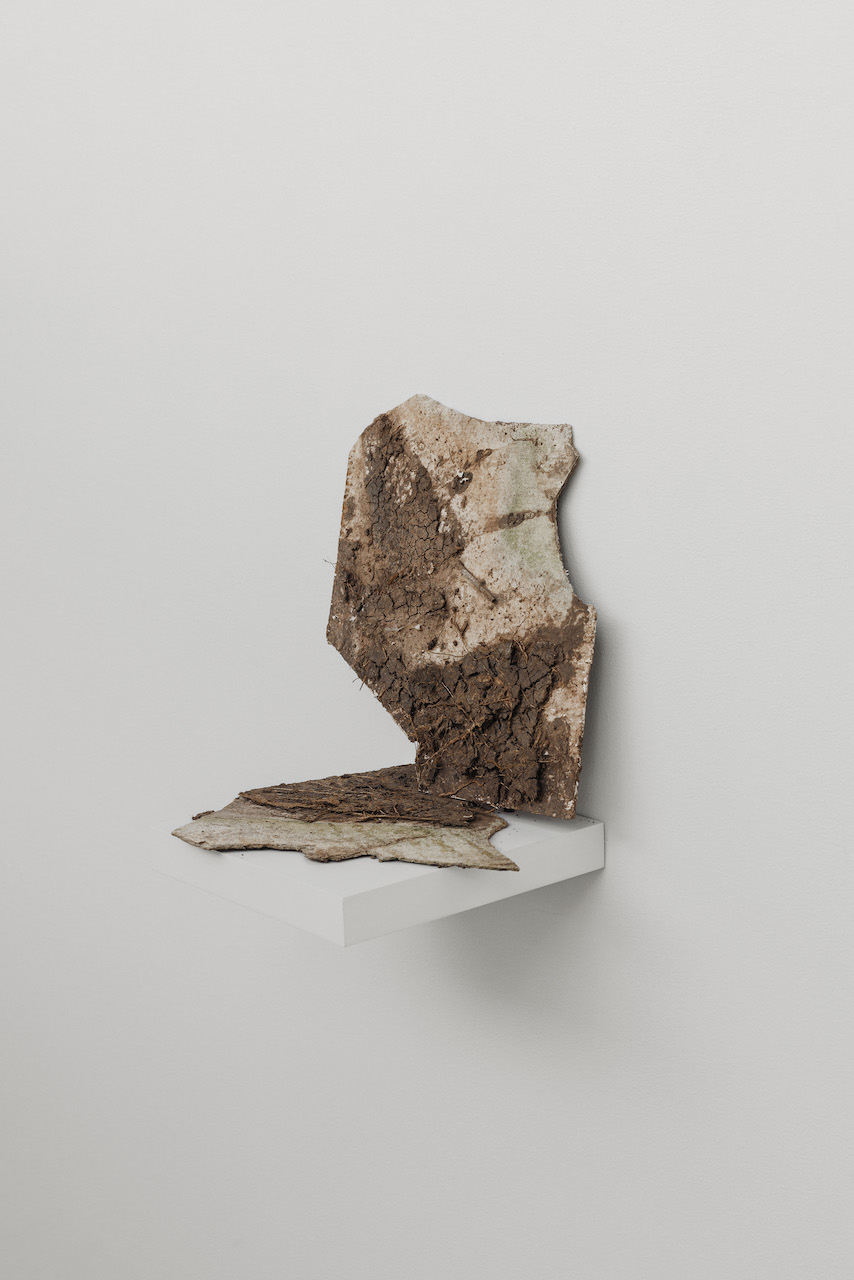
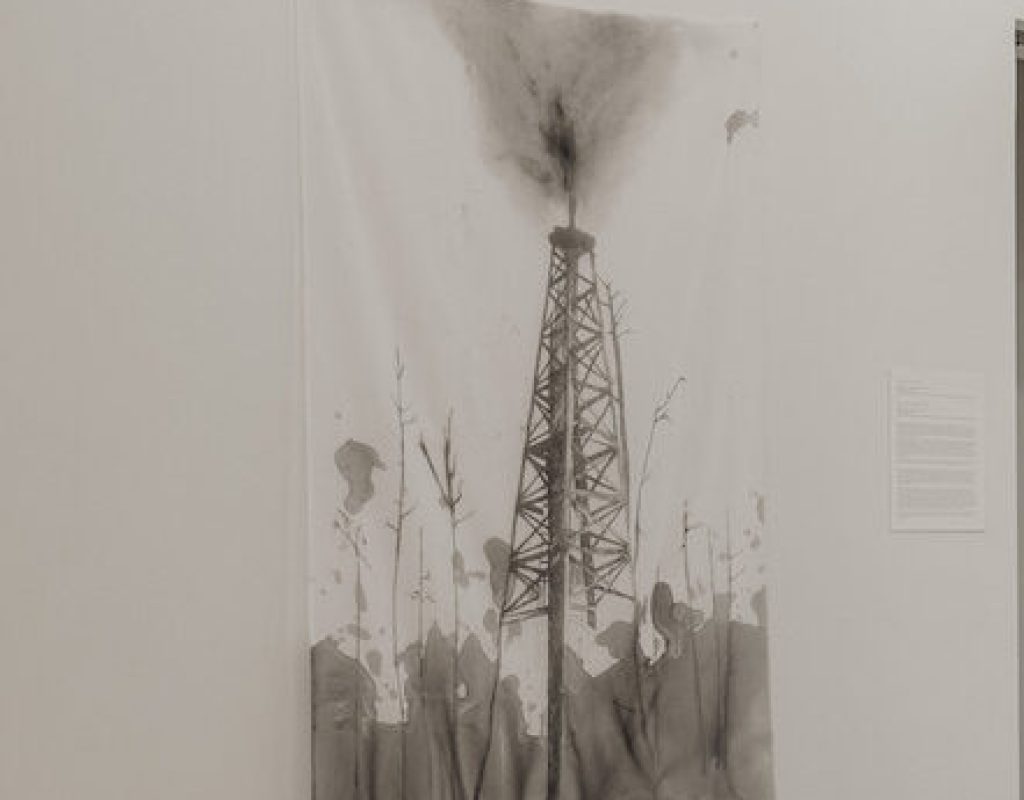
Gushing Oil Derrick in Saratoga
data sheet
DETALLES DEL PROYECTO
Oil and gas production in the Big Thicket region, north of Beaumont, Texas began in the 1800s due to the geological formations that shaped the economies of the area prior to industrialization. Sour Lake, south of the Thicket’s boundary, was historically heralded by Native tribes (including the Tonkawas, Lipans and Wichilas) to meet and use the waters that were laced with sulphur for medicinal purposes. By 1850, the waters of the lake and nearby springs became a health resort for visitors to seek treatment and receive mud and mineral baths. Waters from the lake would be bottled up and sold in Houston and Galveston.
In 1866, attempts to drill for oil in Sour Lake found little success due to outdated equipment such as cable rigs generated by steam power. In 1900, a rotary rig at Spindletop ushered in a major oil boom, which subsequently swept the Big Thicket region. Gushers would often spurt for hours, and the oil would saturate the land and flow into streams. Even after the gusher was under control, seepage was still a regular part of oil operations in the region. Oil drilling continued at the southern edge of the Big Thicket region until the 1930s as the industry pushed north and east, and by the 1950s, much of the Big Thicket was home to some level of oil and gas activity. In the 1960s, a National Park Service survey team analyzed the situation and couldn’t find more than 5,000 contiguous acres that had not been disturbed by roads, or altered from their original state.
The Big Thicket is now a national preserve, and sub-surface mineral rights are privately held. Congress did not authorize the federal acquisition of these rights, and oil and gas extraction continues in and around the preserve today.
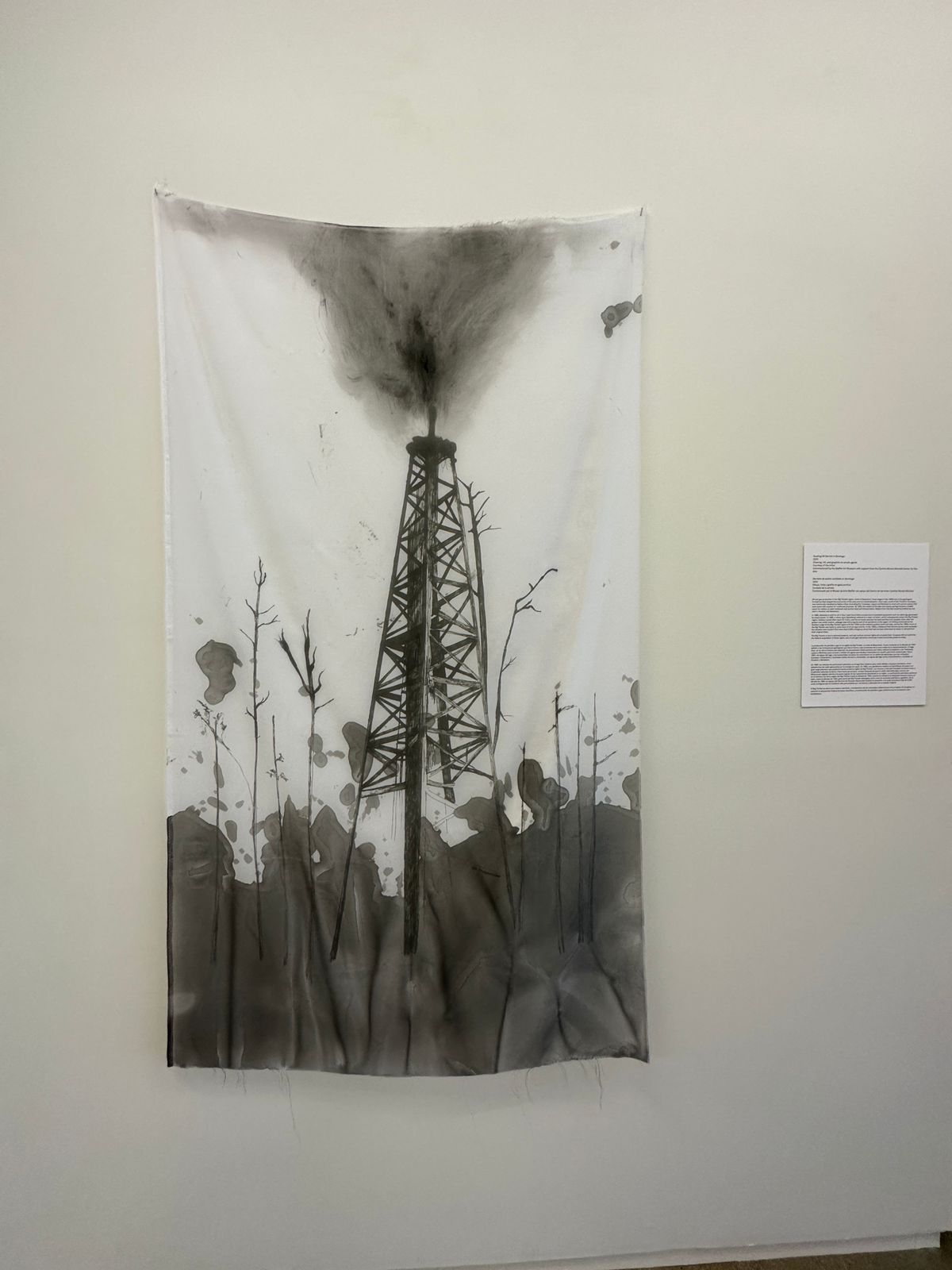
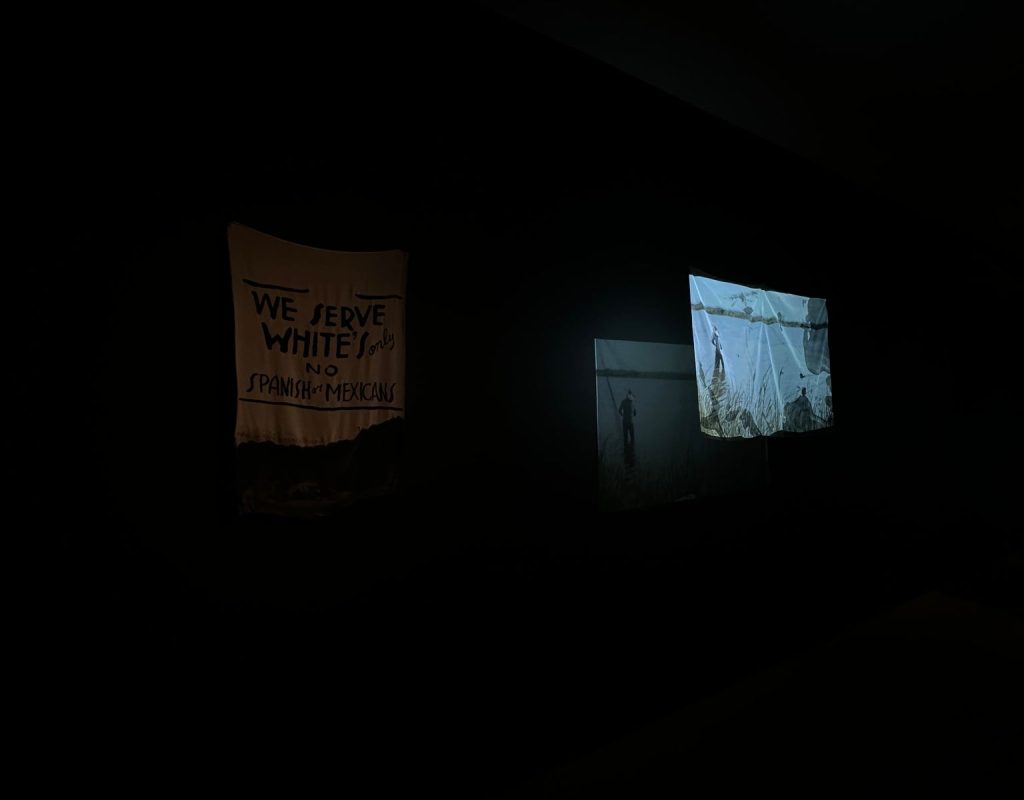
We Serve White’s Only No Spanish or Mexicans & Pescador
Data Sheet. We Serve White’s Only No Spanish or Mexicans.
Data Sheet. Pescador
DETALLES DEL PROYECTO
Cotton was first grown in Texas during Spanish colonization. Documented reports from missions at San Antonio in 1745 indicate that several thousand pounds of cotton were harvested annually. Over time, the source of labor for cotton production was colonized peoples, which subsequently changed the relationship many had to land, water, and nature.
Throughout the industrialization of cotton farming in the 19th and 20th centuries, class and racial division deepened amongst white landowners, Black Americans, and Mexican Americans. Signs refusing Mexican admittance to public establishments were common throughout Texas, as seen in the work We Serve White’s Only No Spanish or Mexicans. This sign was painted on the wall of a restaurant in San Antonio around 1935-37. The image is now housed in the Russell Lee Photograph Collection at the Center for American History at the University of Texas at Austin.
Another piece of the exhibition that alludes to the passage of Mexicans through Texas is the video Pescador, which shows us a poaching fisherman on the banks of Buffalo Bayou. Sample of the presence of Mexican Americans in Houston.
Commissioned by the Blaffer Art Museum with support from the Cynthia Woods Mitchell Center for the Arts
